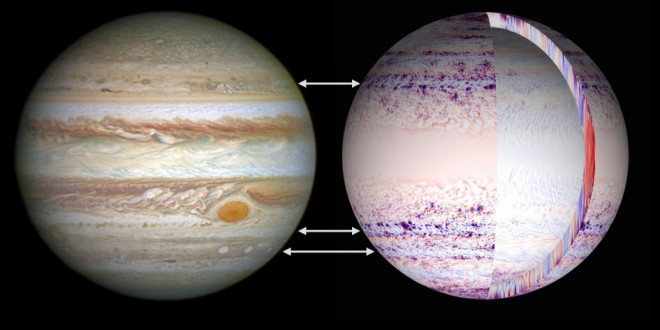Storms on Jupiter and Saturn are being 3D simulated by researchers at the University of Alberta.
“Since the pioneering telescope observations of Giovanni Cassini in the mid-17th century, stargazers have wondered about the bands and spots of Jupiter,” says Moritz Heimpel, a physics professor at the U of A whose study produced the simulations of the observable phenomena. The bands he references indicate jet streams while the spots signify storms; Heimpel is studying the dynamics between the two.
“The average citizen can now pick up a backyard telescope and see the structures that we write about today. However, even in the present age with the Cassini spacecraft orbiting Saturn and the Juno craft approaching Jupiter, there is considerable debate about the dynamics of the atmospheres of the giant planets.” Heimpel notes that despite 350 years of observation, the origin and dynamics of planetary jet streams and vortices or planetary storms remain debated.
Shallow weather layer simulations have struggled to adequately reproduce the jet streams on Jupiter and Saturn, and previous deep-flow models have not reproduced vortices. Heimpel and his colleagues have taken this challenge to the next level, using fluid dynamics equations and supercomputers to produce more realistic simulations that give insight into the origin of both features.
“One of the big questions we have is how deep these structures go,” says Heimpel. “These storms are embedded in these jet streams, and there’s no solid surface to stop them. Our simulations imply that the jet streams plunge deep into the interior, while the storms are rather shallow.”
Unlike great storms on Earth, which eventually lose steam after encountering land mass, planetary storms can continue for centuries.
“At its core, our research is curiosity-based, and our ideas are driven by observations. We have a wealth of those from NASA space missions and ground-based telescopes,” says Heimpel. “Now we want to match the observations with the theory.”
Heimpel notes that he and his colleagues will push their research even further in the coming year with the Juno spacecraft arriving in one of Jupiter’s polar orbits in the summer of 2016 and the Cassini mission—in its final phase—moving into a polar orbit of Saturn in 2017.
“These two missions will be key to verifying some of the predictions of our computer simulations. And more importantly, the missions will lead to new questions and controversies that we will address with ever more sophisticated analysis.”
Heimpel and his group at the U of A are one of only a few teams in Canada using high-powered supercomputers to solve problems in global atmospheric and interior dynamics of the planets. The group is part of Compute Canada, a nationalized system of resource-sharing across universities.
Agencies/Canadajournal
 Canada Journal – News of the World Articles and videos to bring you the biggest Canadian news stories from across the country every day
Canada Journal – News of the World Articles and videos to bring you the biggest Canadian news stories from across the country every day



